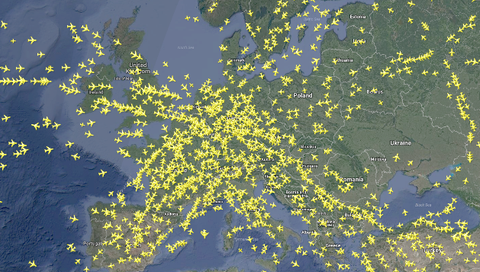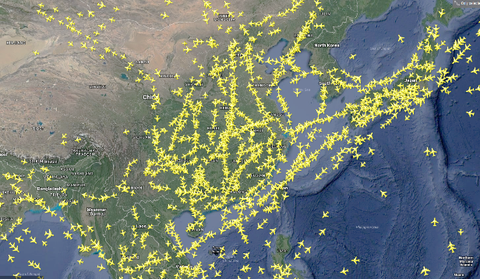UBIQUITOUS
Project informationen
- Funded by DFG
- In cooporation with Chair of Econometrics and Statistics, esp. in the Transport Sector
- Duration of 3 years, started in August 2019
An efficient air transport system requires both individually locally and flow based globally optimized aircraft trajectories. However, in commercial air transportation, aircraft trajectories have to comply with a variety of legal requirements as declared in the Implementation Rules for Flight Operations (IR-OPS1) covering e.g. minimum fuel requirements for a given flight mission leading to aircraft mass constraints, or lateral path restrictions based on worldwide published available waypoints according to ICAO AIRAC2 and limited number of available cruising pressure altitudes.
An optimization further depends on the network of supply and demand, the available fleet, political decisions and the weather predictability as main input factor for trajectory optimization. This information can be extracted by ADS-B (Automatic dependent surveillance—broadcast) data.

European air traffic network structure

Chinese air traffic network structure
Thanks to ICAO's mandate on aircraft ADS-B installation and free accessible data community like Opensky Network, open flight track data including position, altitude, velocity and vertical speed of commercial aircraft has worldwide become available. These data provide an alternative source for modeling aircraft performance while considering environmental unpredictability. Some literature already explores trajectories clustering and predicting using machine learning methods regarding environmental constraints and uncertainties. However, it remains a challenge to analyze data not only with enormous volume but also generating at a considerable velocity. Conclusive results are not yet fully yielded.
The research project "UBIQUITOUS" aims to study and recognize patterns of historical trajectories in ADS-B data. Using identified features, this research proceeds to improve classification of ATM (Air Traffic Management) structure, airline network, routing structure and fleet scheduling behaviors. With better understanding of traffic pattern, upgraded trajectories regarding cost, fuel and climate impact are supposed to be suggested using data driven approaches.
Unsupervised learning methods such as K-means, K-nearest neighbor and hierarchical clustering can be used to investigate clustering of single trajectories. For airline network structures, graphic network models could be applied to do comparative analysis about patterns of graph in China and Europe. Besides descriptive analysis, traditional statistical models as regression and machine learning methods like Support vector machine regression, decision tree regression and neural network regression can model improved trajectory forecasting.
- Judith Rosenow, Jakub Hospodka, Sébastian Lán, Hartmut Fricke, (2023): Validation of a Contrail Life-Cycle Model in Central Europe, Sustainability 15(11):8669, DOI:10.3390/su15118669
- Judith Rosenow, Hartmut Fricke and Lance Sherry, (2023): Time of the day-dependent impact of Contrail Avoidance Strategies on Airline Delay Costs, Fifteenth USA/Europe Air Traffic Management Research and Development Seminar (ATM2023), Savannah, Georgia
- Judith Rosenow and Hartmut Fricke, (2022): When do Contrails cool the Atmosphere? SESAR Innovation days 2022, Budapest, Hungary
- Gong Chen, Hartmut Fricke, Ostap Okhrin and Judith Rosenow, (2022), Importance of Weather Conditions in a Flight Corridor , Stats 2022, 5 (1), 312-338;https://doi.org/10.3390/stats5010018
- Judith Rosenow, Hartmut Fricke (2019):Condensation Trails in Trajectory OptimizationThirteenth USA/Europe Air Traffic Management Research and Development Seminar (ATM2019), 2019
- Judith Rosenow, Hartmut Fricke (2019):Individual Condensation Trails in Aircraft Trajectory Optimization, Sustainability, Volume 11, Issue 21, DOI: 10.3390/su11216082
- Judith Rosenow, Hartmut Fricke, Tanja Luchkova, Michael Schultz (2018): Minimizing contrail formation by rerouting around dynamic ice-supersaturated regions, Aeronautics and Aerospace Open Access Journal, Volume 2, Issue 3
- Judith Rosenow, Martin Lindner, Hartmut Fricke (2017): Impact of climate costs on airline network and trajectory optimization: a parametric study, CEAS Aeronautical Journal, Volume 8
- Judith Rosenow (2016):Optical Properties of Condensation Trails, Dissertation, Technische Universität Dresden
-
Stanley Förster, Judith Rosenow, Martin Lindner and Hartmut Fricke (2016): A toolchain for optimizing trajectories under real weather conditions and realistic flight performance , Greener Aviation, Brussels
-
Judith Rosenow and Hartmut Fricke (2015): Angle dependent extinction of solar radiation by individual condensation trails, TAC-4 Proceedings, Bad Kohlgrub
-
Michael Kaiser, Judith Rosenow, Hartmut Fricke and Michael Schultz (2012),
Tradeoff between optimum altitude and contrail layer to ensure maximum ecological en-route performance using the enhanced trajectory prediction model (ETPM), Proceedings of the 2nd International Conference on Application and Theory of Automation in Command and Control Systems
-
Judith Rosenow, Michael Kaiser and Hartmut Fricke (2012),
Modeling Contrail life cycles based on highly precise flight profile data of modern aircraft, 5th International Conference on Research in Air Transportation, Berkely
-
Judith Schiller, Michael Kaiser, Michael Schultz, Hartmut Fricke (2010), Impact of ocean currents on contrail formation on global scale, 9th Eurocontrol Innovative ATM Research Workshop, Bretigny, France
Minor Project 2019 Extraction of traffic flows from individual aircraft trajectories
Ansprechpartner
 © Sven Ellger
© Sven Ellger
Research Associate
NameDr.-Ing. habil. Judith Rosenow
Send encrypted email via the SecureMail portal (for TUD external users only).
Chair of Air Transport Technology and Logistics
Visiting address:
Gerhart-Potthoff-Bau (POT), Room 165a Hettnerstraße 1-3
01069 Dresden
 © Ostap Okhrin
© Ostap Okhrin
Wissenschaftlicher Mitarbeiter
NameMr Gong Chen M.Sc.
Send encrypted email via the SecureMail portal (for TUD external users only).
Professur für Ökonometrie und Statistik, insb. im Verkehrswesen
Professur für Ökonometrie und Statistik, insb. im Verkehrswesen
Visiting address:
Falkenbrunnen, 1. Obergeschoß, Raum 131 Würzburger Str. 35
01187 Dresden
Office hours:
nach Vereinbarung per E-Mail
